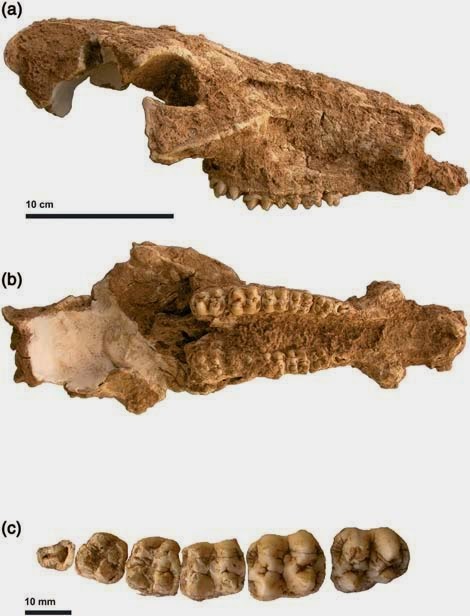Pigs have been important parts of African faunas from the Miocene
onwards, and have been extensively used to interpret environments and date
strata. Unfortunately a large number of taxa have been erected from limited and
fragmentary material, which has led to doubts about several interpretations of
Miocene and Pliocene deposits that were initially based upon data from Pigs.
The genus Nyanzachoerus was initially
described in 1958 by Louis Leaky, and currently contains at least
eleven species, though it is likely that this is an overestimation of true
diversity, as many species were erected on very limited material.
In a paper published in the journal PLoS One on 27 August 2014, Jean-Renaud Boisserie of the Institut de paléoprimatologie, Paléontologie Humaine: Évolution et Paléoenvironnements at the Université de Poitiers, Antoine Souron, also of the Institut de paléoprimatologie, Paléontologie Humaine:
Évolution et Paléoenvironnements at the Université de Poitiers and of the
Human Evolution Research Center at the University of California, Berkeley, Hassane Taïsso Mackaye
and Andossa Likius of the Département de Paléontologie at the Université de N’Djamena,
Patrick Vignaud, again of the Institut de paléoprimatologie, Paléontologie Humaine:
Évolution et Paléoenvironnements at the Université de Poitiers and Michel Brunet, also of the Institut de paléoprimatologie, Paléontologie Humaine: Évolution
et Paléoenvironnements at the Université de Poitiers and of the Collège deFrance, describe a new species of Nyanzachoerus
from Toros-Ménalla, a fossil producing area in the northern Lake Chad basin,
about 500 km northeast of N’Djamena.
The new species is named Nyanzachoerus khinzir,
meaning ‘Pig’ in Chadian dialect Arabic. Boisserie et al. were cautious about erecting about erecting a new species of
Nyanzachoerus, due to previous
over-description of species within the genus, and because the site has
previously been interpreted as being chronologically and environmentally
similar to sites producing the widespread species Nyanzachoerus syrticus. However the site has now yielded a total of
280 specimens, including six well preserved crania (skulls), and this
interpretation is no longer possible, due to its distinctive dentition.
Partial cranium of Nyanzachoerus khinzir.(A)
Lateral view; (B) ventral view; (C) nuchal view; (D) occlusal view of left
P3-M3. Scale bars equal 10 cm (A–C) and 5 cm (D). Boisserie et al. (2014).
The Toros-Ménalla locality has produced remains of Hippopotamuses,
Elephants, Bovids, Anthracotheriids (explain), Birds, Carnivores and Fish as
well as the Hominid Sahelanthropus tchadensis,
currently the earliest known member of the group. Correlation of the fauna with
that at other sites suggests that the Toros-Ménalladeposits are between 7.4 and
6.6 million years old, while attempts at radiocarbon-dating the Hominid
producing localities here have yielded results of between 7.2 and 6.8 million
years old and between 7.5 and 7.1 million years old.
Crania of
Nyanzachoerus khinzir.(A–C)Male partial cranium in dorsal (A), lateral (B),
and rostral (C) views; (D–E) ventral view of female partial cranium in ventral
(D) and lateral (E) view; (F–G) male partial cranium in dorsal (F) and lateral
(G) views; (H) rostral portion of palate ventral view. Scale bars equal 10 cm
(A–G) and 5 cm (H). Boisserie et al. (2014).
An isotopic analysis of specimens of Nyanzachoerus khinzir suggests that had a mixed diet, but likely to
include a considerable amount of grass, probably feeding largely in a wetland
environment. Combined with previous data on fauna from the area, Boisserie et al. suggest that in the Late Miocene
the Toros-Ménalla area may have been similar to the modern Okavango Delta in
Botswana.
Mandibles of Nyanzachoerus khinzir.(A–C)
male in dorsal (A), lateral (B), and occlusal view of right p2-m3 (C); (D–F)
female mandible in dorsal (D), lateral (E), and occlusal view of right p2-m3
(F).Scale bars equal 10 cm (A–B, D–E) and 2 cm (C, F). Boisserie et al. (2014).
See also…
The Chacoan Peccary (Catagonus wagneri) was first recorded from
pre-Columbian archaeological sites in northern Argentina in 1930, and
subsequently found to be still living in the dry Chacos thorny forests
of northern Argentina, western Paraguay and southeastern Bolivia in the
1970s. The Chacos Forests are hot and dry, with average annual
temperatures over 24˚C and average annual rainfall between 80 and 800
mm. The two...
Pigs (Suidae) are found throughout the Old World. They are members of
the Artiodactyla, the group that also includes Cattle, Deer and
Antelopes (and, curiously, Whales), though they are considered less
highly derived than other members of the group, lacking a rumen
(additional stomach compartment) and retaining four toes on each foot
(though two of these are...
Follow Sciency Thoughts on Facebook.





